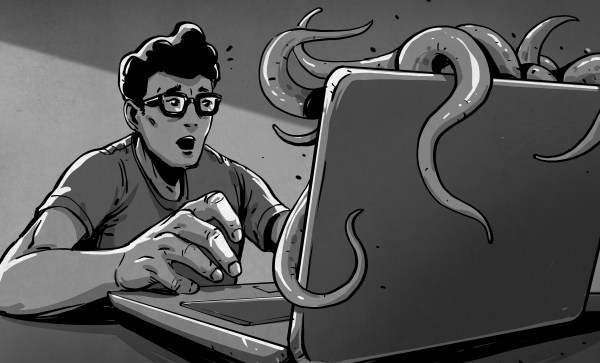For a brief window of time in the mid-2010s, a fairly common joke was to send voice commands to Alexa or other assistant devices over video. Late-night hosts and others would purposefully attempt to activate voice assistants like these en masse and get them to do ridiculous things. This isn’t quite as common of a gag anymore and was relatively harmless unless the voice assistant was set up to do something like automatically place Amazon orders, but now that much more powerful AI tools are coming online we’re seeing that joke taken to its logical conclusion: prompt-injection attacks. Continue reading “Prompt Injection: An AI-Targeted Attack”
vulnerability48 Articles
Arbitrary Code Execution Over Radio
Computers connected to networks are constantly threatened by attackers who seek to exploit vulnerabilities wherever they can find them. This risk is particularly high for machines connected to the Internet, but any network connection can be susceptible to attacks. As highlighted by security researcher and consultant [Rick Osgood], even computers connected to nothing more than a radio can be vulnerable to attacks if they’re using certain digital modes of communication.
The vulnerability that [Rick] found involves exploiting a flaw in a piece of software called WinAPRS. APRS is a method commonly used in the amateur radio community for sending data over radio, and WinAPRS allows for this functionality on a PC. He specifically sought out this program for vulnerabilities since it is closed-source and hasn’t been updated since 2013. After some analysis, he found a memory bug which was used to manipulate the Extended Instruction Pointer (EIP) register which stores the memory address of the next instruction to be executed by the CPU. This essentially allows for arbitrary code execution on a remote machine via radio.
The exploit was found while using Windows XP because it lacks some of the more modern memory protection features of modern operating systems, but the exploit does still work with Windows 10, just not as reliably and with a bit of extra effort required. It’s a good reminder to use open-source software when possible so issues like these can get resolved, and to regularly install security updates when possible. If you’re looking to delve into the world of APRS in more modern times, take a look at this project which adds APRS to budget transceivers. Just make sure you get your license first.
Major Bug Grants Root For All Major Linux Distributions
One of the major reasons behind choosing Linux as an operating system is that it’s much more secure than Windows. There are plenty of reasons for this including appropriate user permissions, installing software from trusted sources and, of course, the fact that most software for Linux including the Linux kernel itself is open source which allows anyone to review the code for vulnerabilities. This doesn’t mean that Linux is perfectly secure though, as researchers recently found a major bug found in most major Linux distributions that allows anyone to run code as the root user.
The exploit is a memory corruption vulnerability in Polkit, a framework that handles the privilege level of various system processes. It specifically impacts the program pkexec. With the proof-of-concept exploit (file download warning) in hand, all an attacker needs to do to escalate themselves to root is to compile the program on the computer and run it as the default user. An example is shown by [Jim MacDonald] on Twitter for those not willing to try this on their own machines.
As bad as this sounds, it seems as though all of the major distributions that this impacts have already released updates that patch the issue, including Debian, Ubuntu, Red Hat, Fedora, open SUSE, and Arch. There is also a temporary workaround that removes read/write permission from the pkexec program so it can’t run at all. That being said, it might be best to check that your Linux systems are all up-to-date and that no strangers have been typing random commands into the terminal recently.
Flaw In AMD Platform Security Processor Affects Millions Of Computers
Another day, another vulnerability. This time, it’s AMD’s turn, with a broad swathe of its modern CPU lines falling victim to a dangerous driver vulnerability that could leave PCs open to all manner of attacks.
As reported by TechSpot, the flaw is in the driver for AMD Platform Security Processor (PSP), and could leave systems vulnerable by allowing attackers to steal encryption keys, passwords, or other data from memory. Today, we’ll take a look at what the role of the PSP is, and how this vulnerability can be used against affected machines.
Continue reading “Flaw In AMD Platform Security Processor Affects Millions Of Computers”
Bluetooth Vulnerability: Arbitrary Code Execution On The ESP32, Among Others
Bluetooth has become widely popular since its introduction in 1999. However, it’s also had its fair share of security problems over the years. Just recently, a research group from the Singapore University of Technology and Design found a serious vulnerability in a large variety of Bluetooth devices. Having now been disclosed, it is known as the BrakTooth vulnerability.
Full details are not yet available; the research team is waiting until October to publicly release proof-of-concept code in order to give time for companies to patch their devices. The basic idea however, is in the name. “Brak” is the Norweigan word for “crash,” with “tooth” referring to Bluetooth itself. The attack involves repeatedly attempting to crash devices to force them into undesired operation.
The Espressif ESP32 is perhaps one of the worst affected. Found in all manner of IoT devices, the ESP32 can be fooled into executing arbitrary code via this vulnerability, which can do everything from clearing the devices RAM to flipping GPIO pins. In smart home applications or other security-critical situations, this could have dire consequences.
Other chipsets are affected to varying degrees, including parts from manufacturers like Texas Instruments and Cypress Semiconductor. Some parts are vulnerable to denial of service, while audio devices may be frozen up or shut down by the attack. The group claims over 1400 products could be affected by the bug.
Firmware patches are being rolled out, and researcher [Matheus E. Garbelini] has released code to build a sniffer device for the vulnerability on GitHub. If you’re involved with the design or manufacture of Bluetooth hardware, it might pay to start doing some homework on this one! Concerned vendors can apply for proof-of-concept test code here.
Razer Mouse Grants Windows Admin Privileges
As the common saying goes, “all networked computers are vulnerable to exploits, but some networked computers are more vulnerable than others”. While not the exact wording from Animal Farm, the saying does have plenty of merit nonetheless. Sure, there are some viruses and issues with Linux distributions but by far most of the exploits target Windows, if only because more people use it daily than any other operating system. The latest Windows 10 exploit, discovered by [jonhat], is almost comically easy too, and involves little more than plugging in a mouse.
While slightly comforting in that an attacker would need physical access to the device rather than simple network access, it is very concerning how simple this attack is otherwise. Apparently plugging in a Razer mouse automatically launches Windows Update, which installs a driver for the mouse. The installation is run with admin privileges, and a Power Shell can be opened by the user simply by pressing Shift and right-clicking the mouse. While [jonhat] originally tried to let the company know, they weren’t responsive until he made the exploit public on Twitter, and are now apparently working on solving the issue.
Others have confirmed the exploit does in fact work, so hopefully there is a patch released soon that solves the issue. In the meantime, we recommend not allowing strangers to plug any devices into your personal computers as a general rule, or plugging in anything where its origins are unknown. Also remember that some attacks don’t required physical or network access at all, like this one which remotely sniffs keystrokes from a wireless keyboard with less than stellar security, also coincidentally built by Microsoft.
Separation Between WiFi And Bluetooth Broken By The Spectra Co-Existence Attack
This year, at DEF CON 28 DEF CON Safe Mode, security researchers [Jiska Classen] and [Francesco Gringoli] gave a talk about inter-chip privilege escalation using wireless coexistence mechanisms. The title is catchy, sure, but what exactly is this about?
To understand this security flaw, or group of security flaws, we first need to know what wireless coexistence mechanisms are. Modern devices can support cellular and non-cellular wireless communications standards at the same time (LTE, WiFi, Bluetooth). Given the desired miniaturization of our devices, the different subsystems that support these communication technologies must reside in very close physical proximity within the device (in-device coexistence). The resulting high level of reciprocal leakage can at times cause considerable interference.
There are several scenarios where interference can occur, the main ones are:
- Two radio systems occupy neighboring frequencies and carrier leakage occurs
- The harmonics of one transmitter fall on frequencies used by another system
- Two radio systems share the same frequencies

To tackle these kind of problems, manufacturers had to implement strategies so that the devices wireless chips can coexist (sometimes even sharing the same antenna) and reduce interference to a minimum. They are called coexistence mechanisms and enable high-performance communication on intersecting frequency bands and thus, they are essential to any modern mobile device. Despite open solutions exist, such as the Mobile Wireless Standards, the manufacturers usually implement proprietary solutions.
Spectra
Spectra is a new attack class demonstrated in this DEF CON talk, which is focused on Broadcom and Cypress WiFi/Bluetooth combo chips. On a combo chip, WiFi and Bluetooth run on separate processing cores and coexistence information is directly exchanged between cores using the Serial Enhanced Coexistence Interface (SECI) and does not go through the underlying operating system.
Spectra class attacks exploit flaws in the interfaces between wireless cores in which one core can achieve denial of service (DoS), information disclosure and even code execution on another core. The reasoning here is, from an attacker perspective, to leverage a Bluetooth subsystem remote code execution (RCE) to perform WiFi RCE and maybe even LTE RCE. Keep in mind that this remote code execution is happening in these CPU core subsystems, and so can be completely invisible to the main device CPU and OS.
Join me below where the talk is embedded and where I will also dig into the denial of service, information disclosure, and code execution topics of the Spectra attack.
Continue reading “Separation Between WiFi And Bluetooth Broken By The Spectra Co-Existence Attack”

















